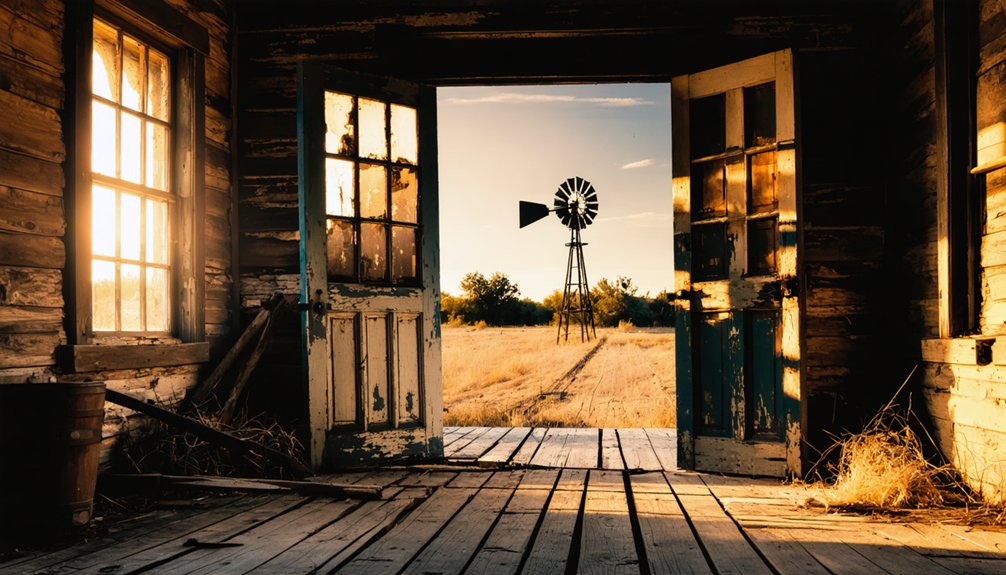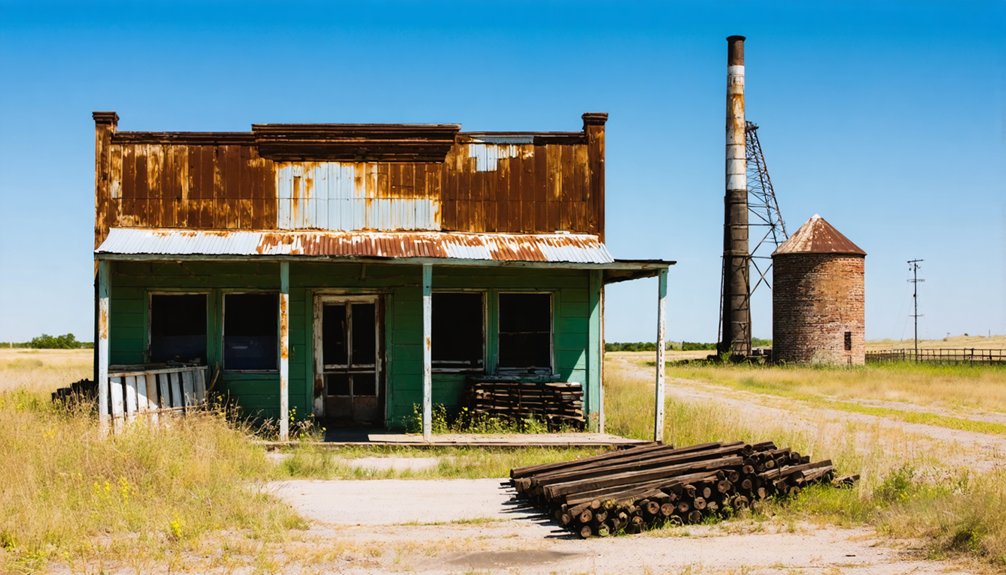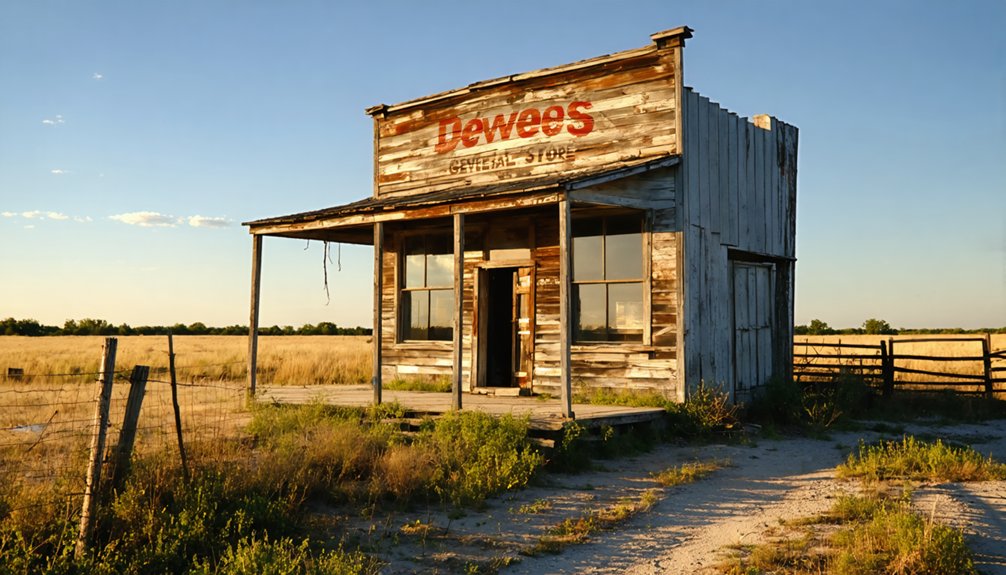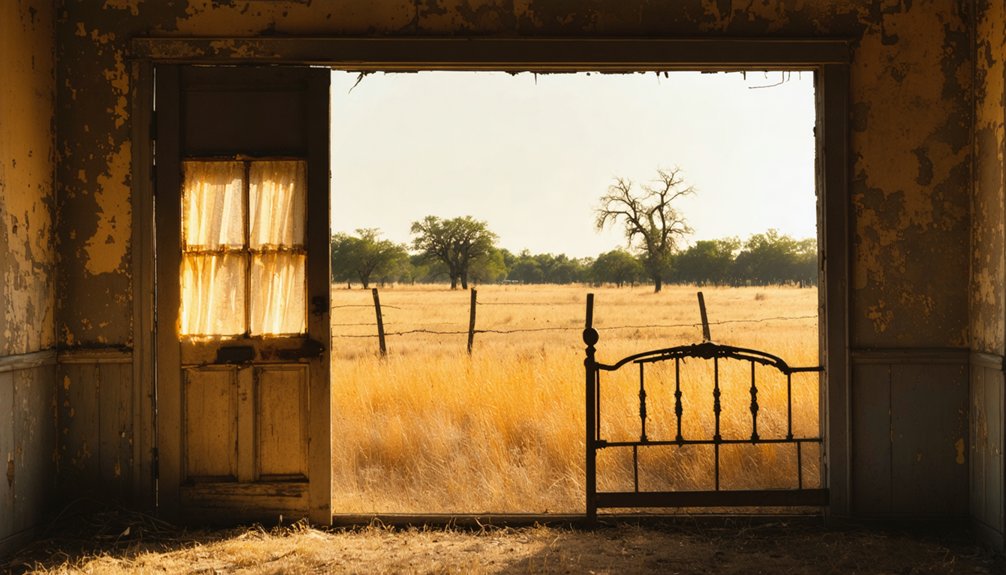You’ll find Dewees at the junction of Farm Roads 541 and 1344 in Wilson County, Texas, where the Dewees brothers once commanded a 100,000-acre cattle empire. After the Civil War, they built a thriving ranching community that drove over 400,000 head of Texas longhorns north by 1882. The town flourished with stores, churches, and a cotton gin until 1911, when postal service ended. Today, it’s one of 31 ghost towns that tell Wilson County’s rich ranching history.
Key Takeaways
- Dewees was a thriving Texas ranching town built around the 100,000-acre cattle empire of John and Thomas Dewees brothers.
- Located at the junction of Farm Roads 541 and 1344, Dewees served as a crucial hub for cattle drives and community gatherings.
- The town featured essential amenities including a general store, cotton gin, post office, and served as a social center for ranchers.
- Economic decline began in the late 1800s due to railroad expansion and fenced ranges affecting the longhorn cattle operations.
- Dewees became one of Wilson County’s 31 ghost towns after 1911 when postal service ended and essential services closed.
The Pioneer Brothers Who Founded a Cattle Empire
Following the Civil War, brothers John Oatman Dewees and Thomas Dewees established what would become one of Texas’s largest cattle empires, spanning nearly 100,000 acres across Karnes, Wilson, and Atascosa counties. The brothers were inspired by early settlers like William B. Dewees who had advocated relocation to Texas.
Post office operations in the early 1900s served as a key communication hub for the growing settlement until its closure in 1911.
You’ll find their success stemmed from strategic partnership dynamics, particularly their alliance with James F. Ellison in the late 1870s. While the Dewees brothers excelled at cattle procurement, gathering massive herds of Texas Longhorns, Ellison brought essential transportation and sales expertise to the operation.
Together, they’d move 20,000 to 40,000 head annually up the Chisholm Trail, hitting a remarkable peak of 100,000 cattle in 1874. They constructed the longest three-plank fence ever built – stretching 211 miles – to manage their expanding operation, which would ultimately drive over 400,000 cattle north between 1871 and 1882.
Life on the Historic Dewees Ranch
While the sprawling Dewees Ranch operated at peak efficiency during the 1870s, daily life on the property remained remarkably consistent through the early 20th century.
You’d find ranch life centered around managing vast herds, with up to 800 cattle grazing across 2,500 acres. Family dynamics shaped the social structure, as ranch managers often raised large families, including one couple with eight children. The talented vaqueros of Texas were instrumental in developing the region’s cattle-handling techniques. The Dewees Store and Gin became a central gathering spot where ranchers socialized while waiting for their cotton to be processed.
Living conditions could be tough, with some workers residing in tents, yet the community’s resilience shone through.
- Seven herding dogs helped manage daily cattle operations
- Ranch hands tackled diverse tasks from trail driving to pasture management
- A massive 211-mile-long three-plank fence supported livestock control
- Spouses faced challenges with remarkable determination
- Extended families shared labor responsibilities across generations
Strategic Location and Natural Landscape
You’ll find Dewees positioned at a critical crossroads in Wilson County, where its strategic placement near major cattle driving routes enabled the ranch to move tens of thousands of Texas Longhorn annually during peak operations.
The gently rolling terrain and natural water sources created ideal conditions for extensive ranching operations across the brushland and pastures typical of South Texas. The location appears in many surname-based records documenting early Texas settlements. Much like the abandoned courthouse in Styles, Texas, the area represents a piece of vanishing Texas history.
The area’s natural landscape, with its relatively flat topography and soil composition suitable for both cattle grazing and cotton farming, supported the economic backbone of the community through the late 19th and early 20th centuries.
Crossroads Near River Junction
Although Junction, Texas sits miles from the ghost town of Dewees, its strategic position at the confluence of the North and South Llano Rivers made it an important crossroads for historic trade routes.
You’ll find this river confluence created natural pathways that shaped transportation routes throughout Texas history, connecting crucial trails and modern highways.
- The Chihuahua Trail and Chisholm Trail intersected here, now marked by I-10 and US-83
- Fertile land and limestone bluffs attracted early settlers and Native Americans
- The rivers formed natural travel corridors through challenging terrain
- Junction became the county seat in 1876, cementing its regional importance
- The location bridged the change between arid West Texas and the Hill Country
Known as the Land of Living Waters, Junction’s abundant waterways continue to draw visitors for recreation and outdoor activities. Today, the town’s wool and mohair production remains a vital part of the local economy. These strategic crossroads continue to influence travel patterns and regional connectivity, preserving Junction’s role as a crucial transportation hub.
Ranch-Friendly Rolling Terrain
The rolling terrain of Dewees shaped its destiny as a premier ranching settlement in Wilson County.
You’ll find gentle slopes and natural drainage patterns that create ideal conditions for sustainable grazing, while the undulating landscape provides sheltered areas for livestock during harsh South Texas summers.
The land’s natural features made it perfect for cattle movement, especially during the post-Civil War era when founders John Oatman and Thomas Dewees capitalized on these advantages.
You can still see how the terrain’s natural corridors facilitated massive Texas Longhorn drives.
Located at the junction of Farm Roads 541 and 1344, Dewees’s strategic position enhanced its ranching success.
The hardy native grasses and soil composition continue to support both cattle operations and crop production, maintaining the area’s historical legacy of agricultural prosperity.
The region’s prominent ranching heritage is evidenced by historic properties like Camp Ranch that remain operational today.
Rise of a Texas Ranching Community
In the 1870s, you’ll find the origins of Dewees when brothers Thomas and John Dewees established their vast cattle operation spanning nearly 100,000 acres across southwestern Wilson County.
You can trace the family’s determined spirit through Thomas Dewees’s famous pursuit of cattle thieves all the way to Brownsville to recover his stolen livestock.
The Dewees brothers‘ pioneering vision transformed their holdings into a thriving ranching empire, complete with extensive infrastructure for managing large herds of distinctive longhorn cattle destined for major market drives.
Today, the historic Dewees Remschel House stands as a testament to the family’s legacy, having been relocated from Gonzales to the ranch property in 1982.
Pioneer Ranching Roots
Following the Civil War, ambitious ranching pioneers John Edward Dewees and his brothers transformed vast stretches of South Texas wilderness into one of the region’s largest cattle operations.
Their pioneer spirit drove them to acquire over 90,000 acres across Karnes, Wilson, and Atascosa counties, building a ranching heritage that would define the region for generations.
- Borrowed capital funded their initial cattle operations, showcasing their bold entrepreneurial vision
- Built an impressive 211-mile three-plank fence, the longest in Texas at that time
- Constructed robust corrals using oak rails and cedar posts from Hays County
- Managed herds of up to 2,500 head during their legendary cattle drives
- Delivered over 400,000 cattle to northern markets by 1882, utilizing the famous Chisholm Trail
Cattle Empire Emerges
Building upon their pioneer foundations, John Edward Dewees and his brothers steadily transformed their initial ranching venture into one of Texas’s most formidable cattle empires.
You’ll find their vast 100,000-acre operation stretched across three counties, showcasing ranch innovations like their record-breaking 211-mile three-plank fence.
In 1871, they partnered with James F. Ellison, revolutionizing cattle marketing. Together, they’d control two-thirds of Texas’s northern cattle drives, moving over 400,000 head by 1882.
Their strategic management of cattle genetics through selective breeding of Texas longhorns, combined with efficient drive operations, positioned them as industry leaders.
Each spring, they’d gather thousands of steers for the epic journey up the Chisholm Trail, where their premium longhorns commanded top dollar at northern railheads.
The Golden Age of Cattle Drives

While cattle movement had existed in Texas since Spanish colonial times, the true golden age of cattle drives emerged after the Civil War, spanning from 1865 to the mid-1890s.
You’ll find this period marked by unprecedented scale, with about 5 million cattle moved northward along famous routes like the Chisholm Trail. Cattle trail innovations like Goodnight’s chuckwagon and the rise of cowboy culture transformed the Texas landscape.
- In 1866, over 260,000 cattle crossed the Red River heading north
- Drives typically launched in spring after roundups
- Trail bosses led crews of about 12 cowhands
- Multiple owners consolidated their herds for efficiency
- The Chisholm Trail peaked around 1871 before railroad expansion
These drives helped integrate Texas’s economy with broader markets, moving cattle to railheads where they’d be shipped to eastern urban centers.
Daily Operations and Ranch Management
The Dewees brothers transformed Texas ranching with their impressive 90,000-acre operation spanning Karnes, Wilson, and Atascosa counties. You’d find their systematic approach to land management reflected in their careful attention to cattle health and pasture rotation across their vast holdings.
To manage such an extensive operation, they’d established a well-organized workforce of eleven men per wagon outfit, with each rider supported by six horses. Their innovative infrastructure included a remarkable 211-mile three-plank fence system for effective herd containment.
They’d coordinate complex daily tasks, from gathering and sorting thousands of Texas Longhorns to managing strategic water access points along the San Antonio River. Schneider’s Store, established in 1932, served as their essential supply hub, while the addition of a cotton gin showcased their operational diversity.
Notable Buildings and Town Infrastructure

Anchoring Dewees’s architectural heritage, the historic Dewees Remschel House stands as a tribute to the town’s prosperous ranching era.
Relocated in 1983, this late 1860s mansion now serves as a museum and event venue under the Wilson County Historical Society’s care.
The town’s historic infrastructure reflects the self-reliant spirit of Texas ranching communities, featuring practical and social spaces that fostered community cohesion.
- The 130-acre ranch complex showcased innovative 1870s windmill technology
- General stores doubled as commercial hubs and social gathering spots
- Churches and schools formed the backbone of community life
- Local banks, housed in brick buildings, supported the ranching economy
- Post offices served as essential communication centers before their eventual closure
The town’s building layout evolved organically, unrestricted by formal zoning, allowing residents to shape their environment according to their needs.
Decline of a Once-Thriving Town
Despite its robust architectural legacy, Dewees’s path toward becoming a ghost town began in the late 1800s when economic forces reshaped the Texas ranching landscape.
Railroad expansion and fenced ranges dealt heavy blows to the Dewees brothers’ once-profitable longhorn operation, forcing economic diversification through land sales to German and Czech farmers.
While these new settlers initially revitalized the area with onions, grains, and dairy farming, broader regional pressures took their toll.
You’ll find Dewees among Wilson County’s 31 documented ghost towns, marking a common pattern of population migration.
The town’s decline accelerated after 1911 when postal service ended, followed by the closure of schools and other essential services.
Today, only Schneider’s Store remains as a reflection of Dewees’s more vibrant past.
Legacy in Wilson County History

Established in the 1870s, Dewees Ranch left an indelible mark on Wilson County’s development through its transformation from a 100,000-acre cattle empire to a catalyst for agricultural diversity.
Today, you’ll find this legacy preserved in the Dewees Remschel House museum near Poth, where the story of cultural integration and agricultural diversification continues to educate visitors.
- German and Czech settlers brought innovative farming techniques that transformed the region beyond traditional cattle ranching.
- The ranch’s subdivision created opportunities for smaller, diverse farms growing grains, vegetables, and fruit.
- Community institutions strengthened immigrant farming families’ social bonds.
- The Dewees family’s political involvement shaped county governance into the 20th century.
- Cultural festivals, architecture, and place names still reflect this rich heritage of settlement and change.
Frequently Asked Questions
What Happened to the Descendants of the Dewees Brothers?
You’ll find the Dewees family’s legacy impact dwindled as they shifted from vast cattle operations to small-scale farming, with descendants now scattered across Texas, engaging in weekend ranching or non-agricultural work.
Were There Any Notable Conflicts With Native American Tribes in Dewees?
Like shadows in the frontier mist, Dewees saw no major documented Native American conflicts, though the area experienced typical tensions of Colorado County’s settler-tribal relations during 19th-century Texas-Indian wars.
What Was the Average Salary of Ranch Hands at Dewees?
You’ll find historical wages for ranch hands at Dewees matched regional averages, with today’s equivalent ranging from $15-18 per hour, reflecting Texas’s traditional position as a lower-paying state for ranch work.
Did Any Famous Outlaws or Lawmen Ever Pass Through Dewees?
Like a tumbleweed leaving no trace, there’s no evidence that famous outlaws or lawmen ever passed through. Historical records show no outlaw encounters or lawman legends in this ranching-focused community.
How Did the Great Depression Specifically Affect the Dewees Community?
You’ll find that cattle prices plummeted, devastating Dewees’s ranching economy. Despite their community resilience, locals faced severe economic impact as ranches were subdivided and families switched to part-time farming for survival.
References
- http://pacweb.alamo.edu/interactivehistory/projects/rhines/studentprojects/2006/dewees/temp2.htm
- https://www.wilsoncountyhistory.org/talk-dewees
- https://www.uiw.edu/sanantonio/jenningsdewees.html
- https://www.tshaonline.org/handbook/entries/dewees-tx-wilson-county
- https://en.wikipedia.org/wiki/List_of_ghost_towns_in_Texas
- https://meemsinsantone.livejournal.com/59941.html
- https://www.texasescapes.com/SouthTexasTowns/Dewees-Texas.htm
- https://www.tshaonline.org/handbook/entries/dewees-tx-waller-county
- https://02f0a56ef46d93f03c90-22ac5f107621879d5667e0d7ed595bdb.ssl.cf2.rackcdn.com/sites/33158/uploads/46916/66-11120210608-22530-uz10hc.pdf
- https://en.wikipedia.org/wiki/Dewees



